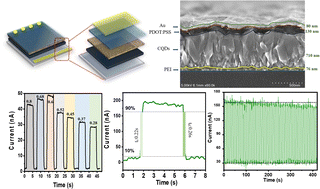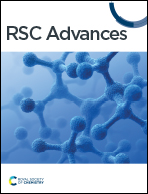A self-powered photodetector through facile processing using polyethyleneimine/carbon quantum dots for highly sensitive UVC detection†
Abstract
Ultraviolet C (UVC) photodetectors have garnered considerable attention recently because the detection of UVC is critical for preventing skin damage in humans, monitoring environmental conditions, detecting power aging in facilities, and military applications. As UVC detectors are “solar-blind”, they encounter less interference than other environmental signals, resulting in low disturbance levels. This study employed a natural precursor (glucose) and a one-step ultrasonic reaction procedure to prepare carbon quantum dots (CQDs), which served as a convenient and environmentally friendly material to combine with polyethyleneimine (PEI). The prepared materials were used to develop a self-powered, high-performance UVC photodetector. The thickness of the constitutive film was investigated in detail based on the conditions of the electron transport pathway and trap positions to further improve the performance of the PEI/CQD photodetectors. Under the optimized conditions, the photodetector could generate a strong signal (1.5 mA W−1 at 254 nm) and exhibit high detectability (1.8 × 1010 Jones at 254 nm), an ultrafast response, and long-term stability during the power supply sequence. The developed solar-blind UVC photodetector can be applied in various ways to monitor UVC in an affordable, straightforward, and precise manner.



 Please wait while we load your content...
Please wait while we load your content...